You’ve put hours into perfecting your product pages, optimizing ads, and crafting irresistible offers. But when you peek into your Shopify dashboard, you see carts piling up and getting abandoned.
Maybe your shoppers got distracted mid‑scroll. Maybe they hesitated over shipping costs. Or maybe, they needed one last nudge to hit “Checkout.” On average, 70–75% of online carts abandon carts before purchase. But no worries, you can recover a big chunk of that lost revenue just by setting up an abandoned cart email campaign that feels human, timely, and on‑brand.
Let’s walk through 15 real abandoned cart email examples and templates that show how different brands turn almost‑losses into easy wins, and how you can adapt them for your Shopify store.
15 Abandoned Cart Email Examples
1. Revival
Subject: So close, yet so far
Why the subject line and email body converts:
This subject line uses a simple, empathetic phrase that taps into the shopper’s near-purchase mindset—acknowledging the gap without pressure. It’s conversational and relatable, creating curiosity and gently prompting the reader to revisit.
The email is visually clean and straightforward, highlighting the abandoned items with imagery and a clear call to action (CTA). This clarity removes any friction, making it effortless for the shopper to return to checkout. The tone feels personal, reminding shoppers they’re almost there without being pushy.

2. Epic Deals
Subject: Is this yours, Smiles Davis?
Why the subject line and email body converts:
Personalization grabs attention immediately by using the recipient’s name. The question format nudges curiosity and ownership, making the reader feel the email is tailor-made, thus increasing open rates. The body follows with a casual, warm tone addressing the shopper by name and showing the items left behind. Inclusion of the customer name combined with product reminders helps the email feel less robotic and more like a friendly check-in.

3. Blueland
Subject: Did you see something you liked?
Why the subject line and email body converts:
The subject line invites reflection rather than pressure, encouraging the shopper to think about what attracted them in the first place. It’s soft, open-ended, which lowers resistance to opening. The email uses bright, clean design, with a focus on product images and a clear CTA. The tone is casual, as if catching up with a friend, which helps in reducing hesitation.
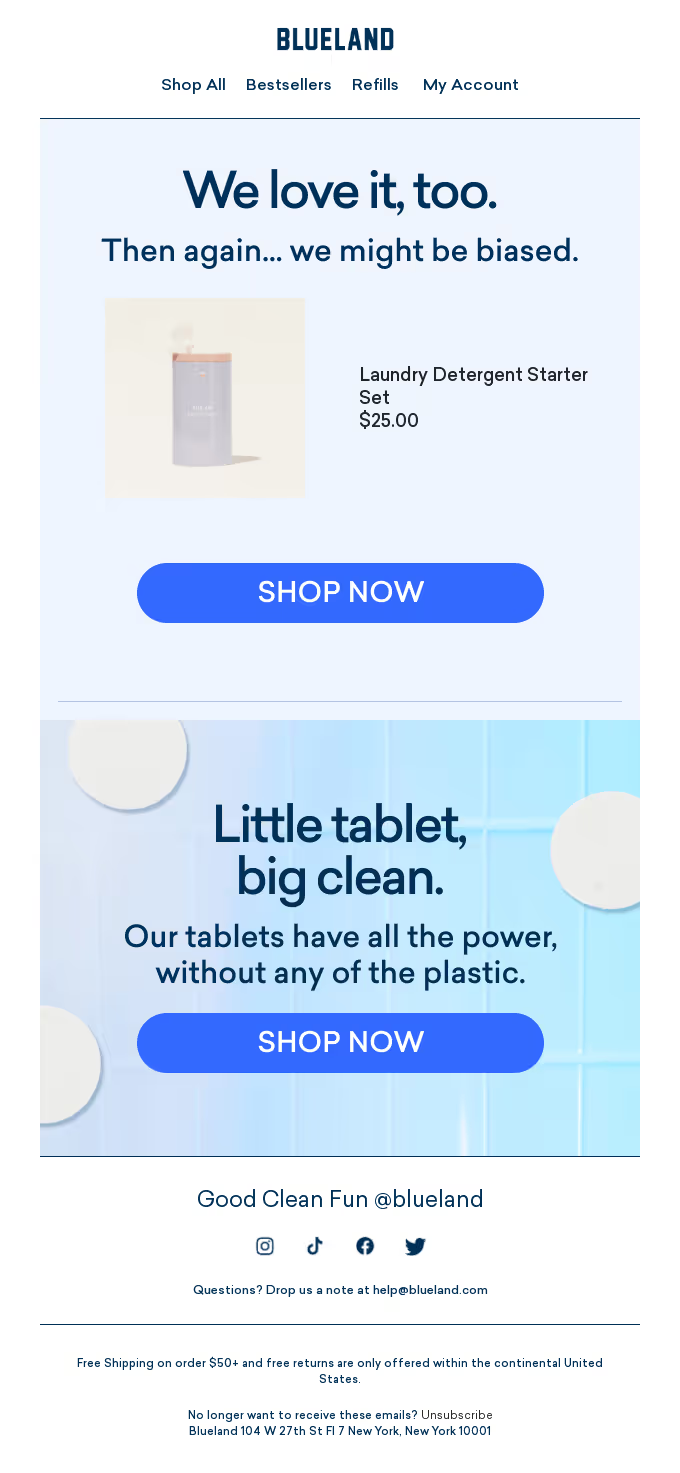
4. Hulu
Subject: TV Fan, Your Free Trial is Waiting
Why the subject line and email body converts:
Hulu leverages direct personalization (“TV Fan”) plus a clear value proposition (“free trial”), making the email both relevant and enticing. The body capitalizes on the subject’s promise by emphasizing an easy return to the free trial, reducing friction with a one-click CTA and reassuring copy. The visual hierarchy keeps focus on benefits and CTA.
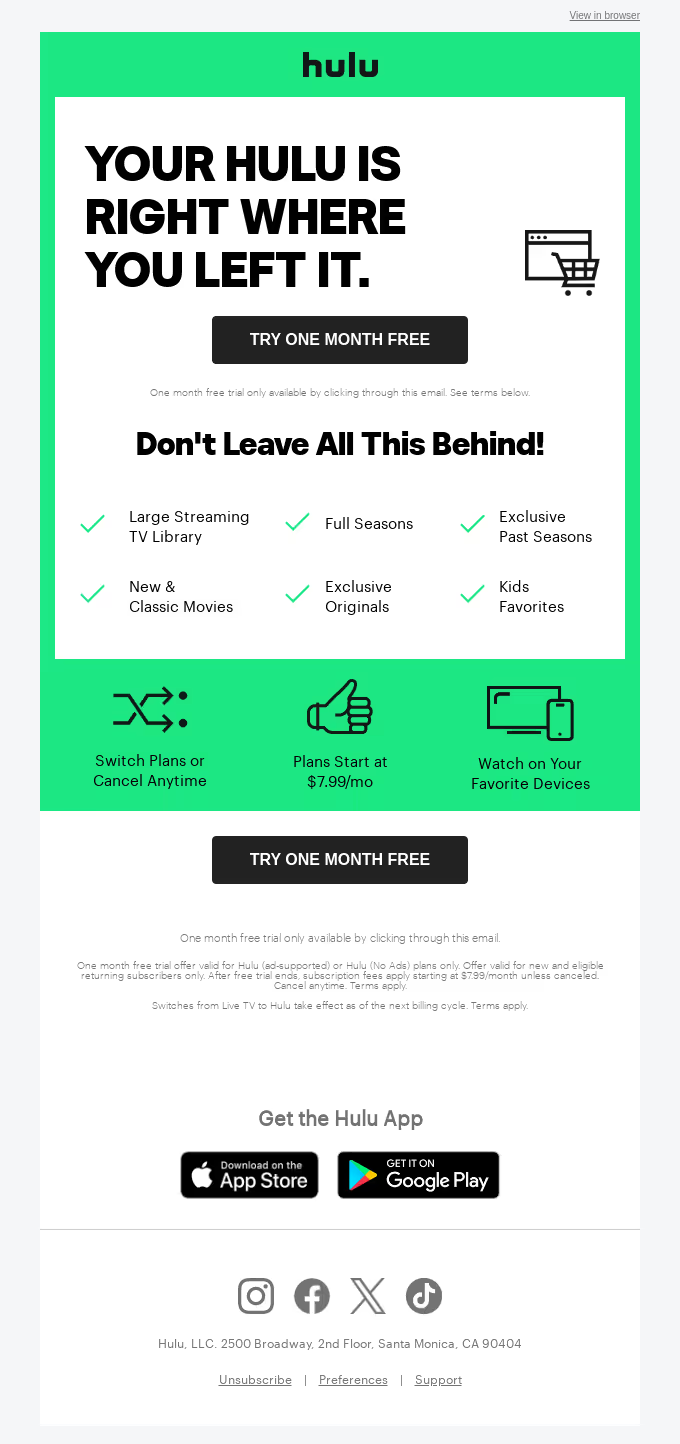
5. Grove Collaborative
Subject: Where’d you go?
Why the subject line and email body converts:
This short, informal subject asks a direct question, sparking curiosity and a sense of mild concern that is friendly rather than pushy. It builds engagement through conversational language. Visually, it’s simple with product reminders and a prominent CTA for resuming the purchase. The tone presumes goodwill—gently inviting the shopper back rather than demanding action.

6. Loftie
Subject: Still not sure?
Why the subject line and email body converts:
This subject taps into buyer hesitation by acknowledging uncertainty—a key reason for cart abandonment. It creates empathy and suggests the email will address concerns, prompting opens. The body supports this by addressing potential doubts, offering reassurance or additional value. It helps remove obstacles without feeling forceful.

7. Chatters Salons
Subject: Don’t miss out! Get it before it’s gone...
Why the subject line and email body converts:
Here, urgency and scarcity drive the subject line. It reminds the reader of limited availability, which is a strong psychological trigger to act. The “...” adds a casual, conversational tone. The email reiterates scarcity and uses a strong CTA to provoke purchase action. The copy and layout make it clear that waiting could mean missing out, motivating faster decisions.

8. Etsy
Subject: Coupon reminder: CactusArchive sent you 20% off
Why the subject line and email body converts:
This subject line brilliantly combines a sense of exclusivity ("CactusArchive sent you") with a concrete incentive (20% off). By presenting the discount as a personal gift or recommendation, it feels less like a mass marketing blast and more like a tailored offer from a trusted source. This increases open rates by appealing to both value-consciousness and social proof. The email focuses heavily on the discount offer, making the value proposition clear and frontloaded. Product images and minimal distractions direct attention to the CTA. This approach addresses the main reason for abandonment—price—and motivates shoppers to act quickly, leveraging the fear of missing out on a good deal.
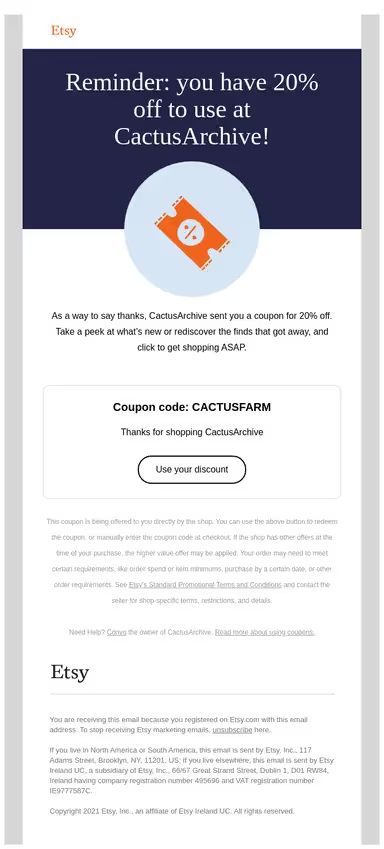
9. Thuma
Subject: Build the perfect bedroom.
Why the subject line and email body converts:
Rather than pushing a sale, this subject line taps into aspiration and lifestyle appeal, inviting the reader to visualize the outcome of their purchase. It’s less about the product and more about the solution or dream, which emotionally resonates and draws interest. The body supports this by showcasing the complementing products in situ, helping shoppers imagine combining these pieces. It’s soft-selling with lifestyle imagery, creating desire organically while the clear CTA subtly nudges checkout completion.

10. McDonald’s
Subject: Your order is ready to place 👍
Why the subject line and email body converts:
Short, casual, and optimistic, this subject feels friendly and supportive rather than salesy. Adding the thumbs-up emoji adds a human touch and positive reinforcement, which builds goodwill. The email keeps it simple and action-oriented. There's no hard sell, just a quick reminder along with an easy pathway to complete the order. This style works well for impulse purchases or food delivery where speed and convenience are top priorities.
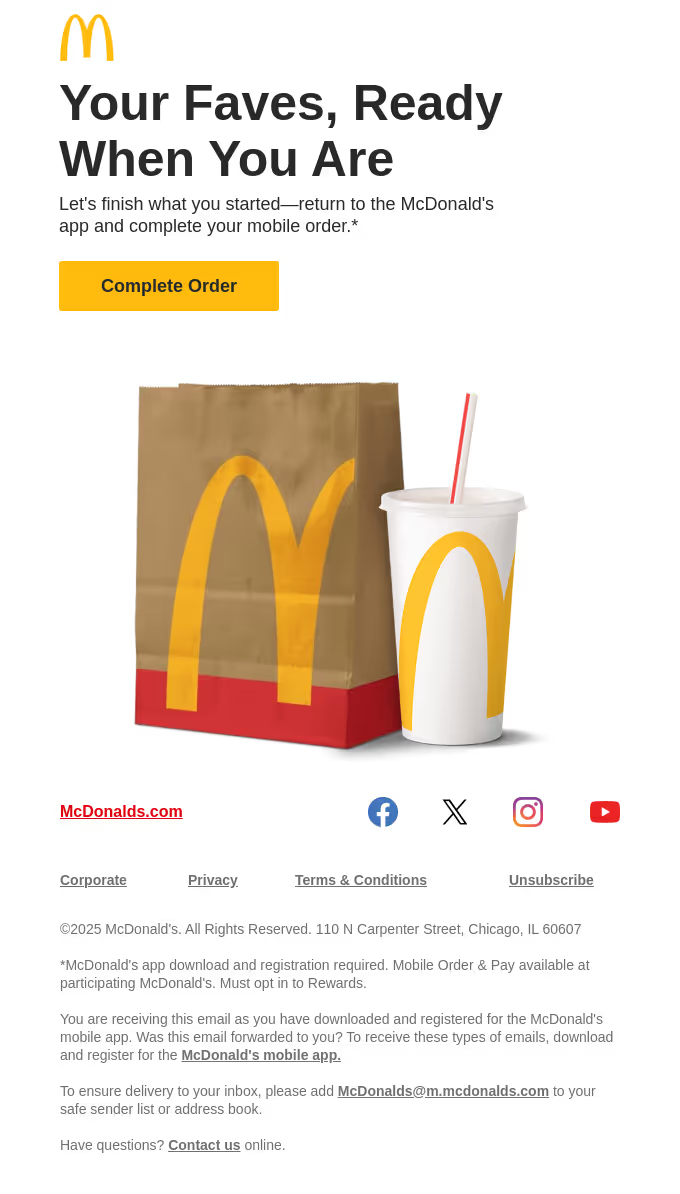
11. Pestie
Subject: Did a bug crash your order?
Why the subject line and email body converts:
Humor and empathy blend here. The subject addresses a potential technical issue, which is a common but overlooked reason for cart abandonment. This playful tone reduces frustration and makes the customer feel understood and cared for. The email follows the joke with a helpful, easy route back to the cart. The lighthearted approach makes the customer more receptive to returning because it removes the cold corporate feel and replaces it with personality.

12. Sling
Subject: Not all streaming is created equal
Why the subject line and email body converts:
This line creates curiosity and differentiates the product by implying superiority, motivating recipients to find out what makes the service special. The wording invites readers to rethink their choices without direct pressure. The body reiterates unique selling points or features that align with the subject’s promise. By highlighting benefits and providing easy CTAs, Sling leverages curiosity to encourage completion.

13. Better Brand
Subject: Want free shipping on something better, Smiles Davis?
Why the subject line and email body converts:
This subject is personalized and incentive-driven. Addressing the recipient by name captures attention, while the offer of free shipping removes a common friction point, appealing directly to shopper hesitations about extra costs. The email emphasizes value and convenience, backed by visuals and a direct CTA. The tone suggests upgrading to better quality paired with the shopping benefit, nudging users gently towards purchase.

14. Something Navy
Subject: We shopped for you
Why the subject line and email body converts:
The subject creates a service-oriented vibe, offering curated selections which appeal to shoppers who might be indecisive or overwhelmed. It sets an expectation that the email contains personalized, thoughtful product recommendations. The body delivers on the promise with handpicked product recommendations alongside the cart content. This reduces the cognitive load on the shopper, making it easier to make buying decisions, which is critical in reducing abandonment.
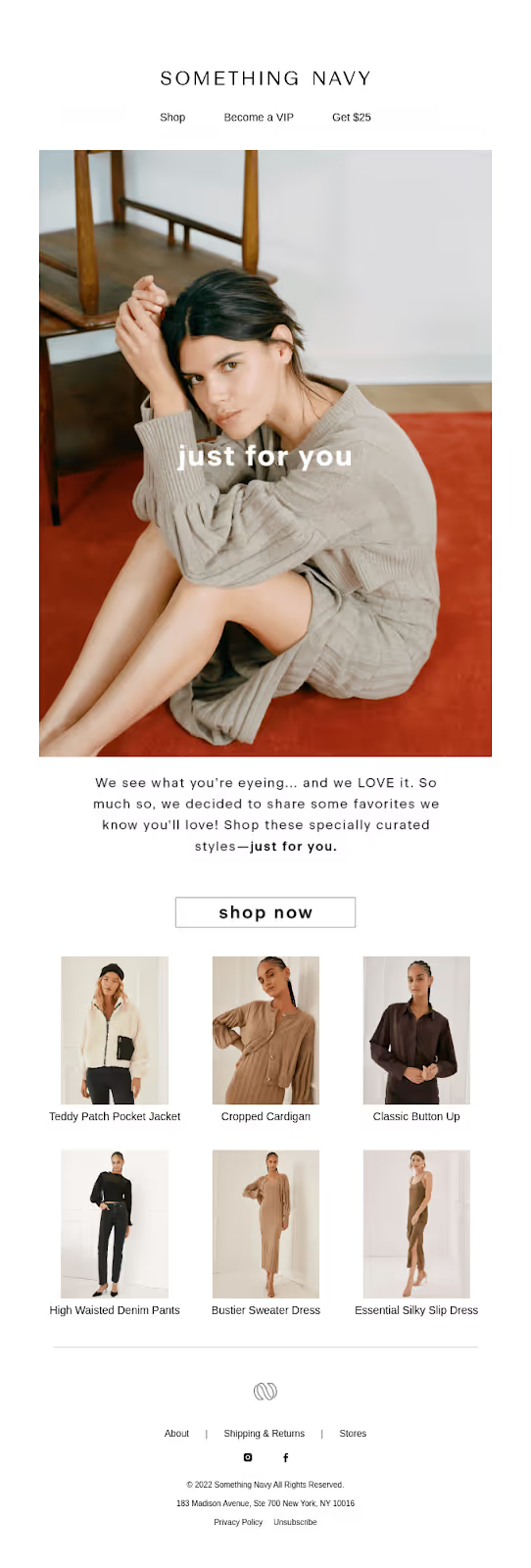
15. United By Blue
Subject: Looking for a sign? Free shipping.
Why the subject line and email body converts:
This clever combination of a motivational prompt ("Looking for a sign?") with a concrete offer (“Free shipping”) intrigues the shopper and strongly addresses common objections about shipping costs. The email places free shipping front and center, paired with images of the abandoned products and clear, accessible CTA buttons. This direct appeal to remove barriers combined with motivational language helps convert hesitant customers.

Turn Abandoned Carts Into Your Store’s Hidden Revenue
Abandoned carts are valuable opportunities waiting to be reclaimed through high-converting emails. Understanding why shoppers leave and how to speak to those reasons with the right abandoned cart email can transform what seems like lost revenue into consistent profits.
The 15 real-world abandoned cart email examples we explored reveal a few clear truths: personalization, timing, clear value, and a conversational tone work best. Whether it’s a friendly reminder, a strategic discount, or a dose of social proof, every element you include builds trust and lowers the barriers holding your customers back.
To truly maximize your cart recovery, remember to send timely follow-ups, keep your emails customer-centric, and always deliver a clear, frictionless path back to checkout.
If building, testing, and optimizing these campaigns feels overwhelming, tools like Yarnit’s Email Campaigns can be a game changer. Yarnit’s AI-powered platform uses AI agents to create time-sensitive promotional content generation and tailor abandoned cart workflows that not only sound human but also adapt to your audience behavior.
Yarnit also offers agentic AI solutions for ecommerce businesses. Its AI agents automate the creation of dynamic, personalized email sequences, including abandoned cart recovery campaigns that adapt to customer behavior and timing. By integrating AI-driven content generation and campaign orchestration, Yarnit helps Shopify store owners recover lost sales with emails that sound conversational and brand-aligned, improving both customer engagement and revenue potential.
Your next sale is just one email away.









